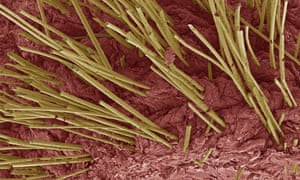Skin grown with follicles, glands and nerves could transform burns treatment and offer alternative to animal testing

Bioengineered skin complete with functioning hair follicles, glands and nerves has been grown using a new technique that could transform burns treatment and end cosmetics testing on animals.
Working with mice, scientists in Japan created the skin by first producing three-dimensional clumps of cells that resembled embryos in the womb.
They then implanted the so-called “embryoid bodies” into immune-deficient mice, where the cells developed further. Next, the maturing cells were grafted on to the bodies of other mice to complete their transformation into skin.
The end result was functional “integumentary tissue”, the deeply layered tissue that allows the skin to work as the body’s largest organ.
“With this new technique, we have successfully grown skin that replicates the function of normal tissue.
“We are coming ever closer to the dream of being able to recreate actual organs in the lab for transplantation, and also believe that tissue grown through this method could be used as an alternative to animal testing of chemicals.”
At the start of the study, cells taken from the gums of mice were turned into induced pluripotent stem cells by exposing them to a cocktail of chemicals that turned back their developmental clock. These were then coaxed to develop into EBs in the laboratory.
Previous attempts at growing skin from stem cells have only got as far as producing implantable sheets of epithelial cells, which formed the outermost skin layer but lacked functional elements such as oil-secreting sebaceous and sweat glands.
The skin produced by Dr Tsuji’s team made normal connections with surrounding nerve and muscle tissue and sprouted hair.
The research, reported in the journal Science Advances, brings effective regenerative treatments for patients with severe burns and skin diseases a significant step closer.
It could also provide an alternative to testing cosmetics and household products, such as detergents, on animals.
Animal cosmetics testing is illegal in the UK and other EU countries but continues in other parts of the world.